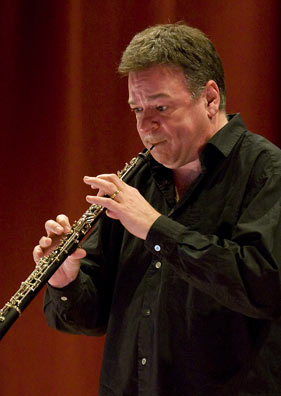Camerata Pacifica
At the Santa Barbara Woman's ClubRockwood, Friday, April 11.

In a season of flux, while their usual home at the Music Academy of the West is undergoing extensive renovation, Camerata Pacifica has gone a-roving, as a genteel squatter in various temporary homes. One of the happier homes has been the historic Santa Barbara Woman’s Club at Rockwood, a fine chamber music venue waiting to happen. Last Friday afternoon, Rockwood provided an ideal atmosphere for one of the Camerata’s wonderful midday “lunchtime concert” indulgences, this one featuring one of the planet’s greatest oboists, the Brit Nicholas Daniel. Fittingly (though not necessarily fortunately), much of the program’s going was British music of the middle 20th century, with a saving grace of a Mozart sonata to cap it off.
Opening the program, Gerald Finzi’s 1936 Interlude for Oboe and String Quartet proved an agreeably post-romantic item, which yearns for and leans back into the comfy chair of late 19th-century expression. There are subtle signs of its 20th-century citizenship, but little that would dissuade us from the prevailing view of the composer as a marginal British sentimentalist. That said, however, the musical forces here were on point in delivering the score for all its soupy worth, and the timbre of strings and an oboe protagonist had a charm all their own, apart from the notes.
Faring better to these ears was composer Herbert Howells’s Oboe Sonata, which was penned amidst the horrors of World War II, in 1943, and a few years after the composer’s nine-year-old son had died of meningitis. Its qualities of melancholy and quiet dread are understandable under the circumstances. Played masterfully here by Daniel and pianist Warren Jones, the piece also works in a generally romantic and tonal terrain, but finds its way to more personal and persuasive places.
Showcasing the oboist without simply offering the soloist a chance to flaunt wares, the piece veers into some vaguely jazzy and spicy passages in the second half, even including some Rite of Spring-like chords which sound out-of-place in the moody garden setting. Mostly, though, Howells’s piece is ruminative and wistful in spirit, and with nothing to give a scare to 20th-century music-phobes.
Coming back to a chamber musical repertoire foundation, Daniel was joined by violinist Catherine Leonard, cellist Lars Hoefs, and violist Richard O’Neill for Mozart’s Oboe Quartet in F, K. 370. Mozart’s lightness and composure came as a relief after the heavy English manners preceding it. In its compact Adagio, the elegant plaintive sonic potential of Daniel’s oboe sang out beautifully, especially in this particularly picturesque room.



